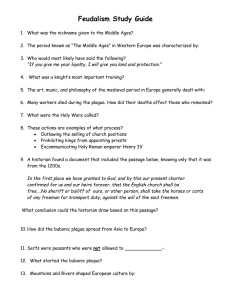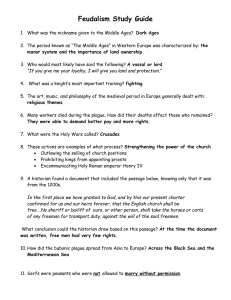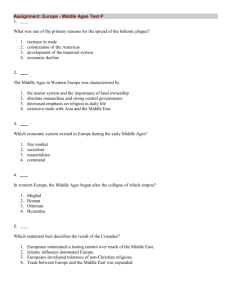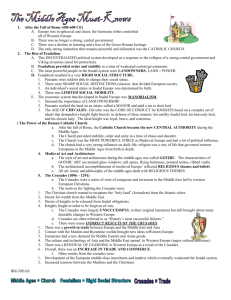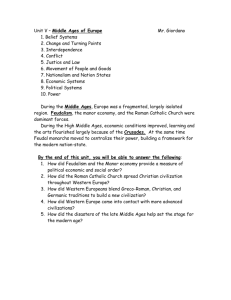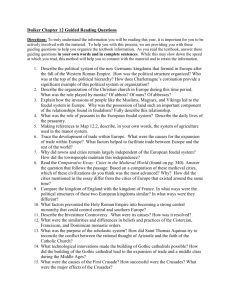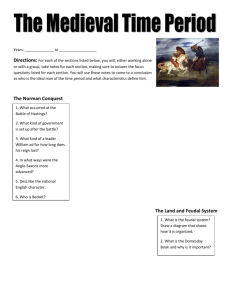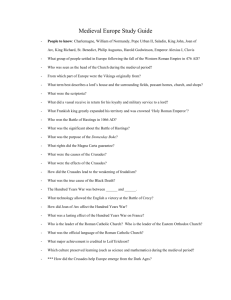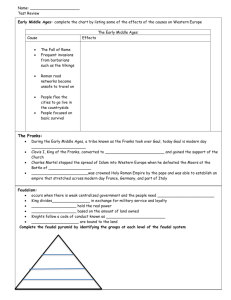Middle Ages/Feudalism Study Guide
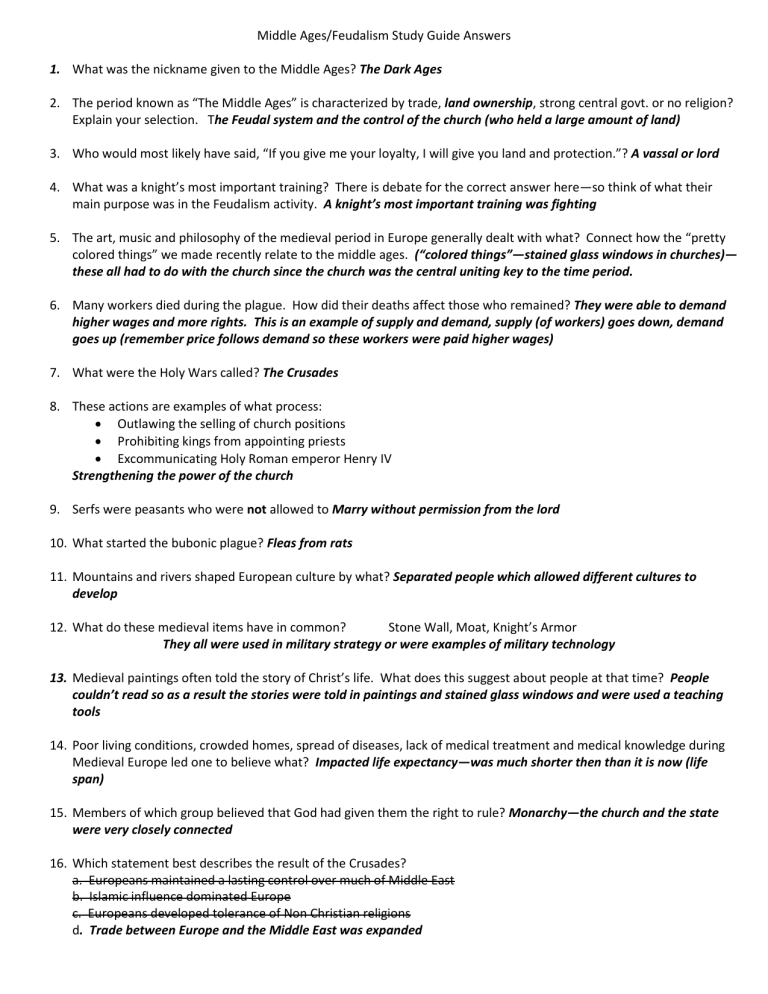
Middle Ages/Feudalism Study Guide Answers
1.
What was the nickname given to the Middle Ages? The Dark Ages
2.
The period known as “The Middle Ages” is characterized by trade, land ownership, strong central govt. or no religion?
Explain your selection. The Feudal system and the control of the church (who held a large amount of land)
3.
Who would most likely have said, “If you give me your loyalty, I will give you land and protection.”? A vassal or lord
4.
What was a knight’s most important training? There is debate for the correct answer here—so think of what their main purpose was in the Feudalism activity. A knight’s most important training was fighting
5.
The art, music and philosophy of the medieval period in Europe generally dealt with what? Connect how the “pretty colored things” we made recently relate to the middle ages. (“colored things”—stained glass windows in churches)—
these all had to do with the church since the church was the central uniting key to the time period.
6.
Many workers died during the plague. How did their deaths affect those who remained? They were able to demand higher wages and more rights. This is an example of supply and demand, supply (of workers) goes down, demand
goes up (remember price follows demand so these workers were paid higher wages)
7.
What were the Holy Wars called? The Crusades
8.
These actions are examples of what process:
Outlawing the selling of church positions
Prohibiting kings from appointing priests
Excommunicating Holy Roman emperor Henry IV
Strengthening the power of the church
9.
Serfs were peasants who were not allowed to Marry without permission from the lord
10.
What started the bubonic plague? Fleas from rats
11.
Mountains and rivers shaped European culture by what? Separated people which allowed different cultures to
develop
12.
What do these medieval items have in common? Stone Wall, Moat, Knight’s Armor
They all were used in military strategy or were examples of military technology
13.
Medieval paintings often told the story of Christ’s life. What does this suggest about people at that time? People couldn’t read so as a result the stories were told in paintings and stained glass windows and were used a teaching tools
14.
Poor living conditions, crowded homes, spread of diseases, lack of medical treatment and medical knowledge during
Medieval Europe led one to believe what? Impacted life expectancy—was much shorter then than it is now (life
span)
15.
Members of which group believed that God had given them the right to rule? Monarchy—the church and the state
were very closely connected
16.
Which statement best describes the result of the Crusades? a. Europeans maintained a lasting control over much of Middle East b. Islamic influence dominated Europe c. Europeans developed tolerance of Non Christian religions d. Trade between Europe and the Middle East was expanded
17.
In the feudal system an individual’s social status was generally determined by what? Birth
18.
Joan of Arc was accused of being what? A witch and she was burned at the stake despite the fact that she was a hero
and led her country’s military with success.
19.
What were several indirect results of the Crusades? TWO—trade (and commerce) increased with the Middle East and the Crusades weakened the Feudal system. Lords and vassal sold their land and freed their serfs to go fight in the
Crusades
20.
In Medieval Europe, what type of person might have spoken these words?
I believe we all have a spark of godly intelligence, that we must live in agreement with nature and that we must develop good character? A stoic
An ecologist
A scientist
A priest
21.
Which of these is not true of the Roman Catholic Church during the Middle Ages?
Church leaders helped govern western Europe
Each parish had its own pope
The church owned valuable land a property
Daily life in villages revolved around the church
22.
Who would have been most likely to make the following statement?
I am traveling to Jerusalem to show God how sorry I am for having sinned. I hope we have a safe journey. A pilgrim
23.
Both the plague and the Hundred Years’ War had what effect? They led to a shift in power from the feudal system to
the common people and monarchs
24.
The Roman Catholic Church during the Middle Ages in Europe can best be described as a church that
Favored separation of church and state
Avoided involvement in social educational matters
Was a strong force that divided many people
Was a stabilizing influence during a period of weak central governments
25.
The Crusades have been called “history’s most successful failure.” Explain this expression. The Crusades did not
achieve their original goal but they brought about many desirable changes to Europe.
26.
What was the name of the document that King John was forced to sign limiting the power of the king? Magna Carta
27.
“All things were under its domain…Its powers were such that no one could hope to escape its scrutiny.” What
European institution during the middle ages was best described in this statement? The church
28.
If you were a customer who bought shoes from a cobbler, how might a guild help you? Guilds would make sure that
you, the customer, purchased a good quality pair of shoes.
29.
In Europe, a long term effect of the Crusades was what? Increase in the demand for products from the Middle East
30.
What does Magna Carta mean? The Great Charter
31.
In Europe during the Middle Ages, the force that provided unification and stability was what? The Roman Catholic
Church
32.
What does the term feudalism mean?
NOTE—the “church” and the “Roman Catholic Church” are one in the same
